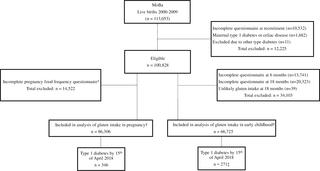Our official English website, www.x-mol.net, welcomes your
feedback! (Note: you will need to create a separate account there.)
Maternal and child gluten intake and association with type 1 diabetes: The Norwegian Mother and Child Cohort Study.
PLOS Medicine ( IF 10.5 ) Pub Date : 2020-03-02 , DOI: 10.1371/journal.pmed.1003032 Nicolai A Lund-Blix 1, 2 , German Tapia 1 , Karl Mårild 1, 3 , Anne Lise Brantsaeter 4 , Pål R Njølstad 5, 6 , Geir Joner 2, 7 , Torild Skrivarhaug 2, 7 , Ketil Størdal 1, 8 , Lars C Stene 1
PLOS Medicine ( IF 10.5 ) Pub Date : 2020-03-02 , DOI: 10.1371/journal.pmed.1003032 Nicolai A Lund-Blix 1, 2 , German Tapia 1 , Karl Mårild 1, 3 , Anne Lise Brantsaeter 4 , Pål R Njølstad 5, 6 , Geir Joner 2, 7 , Torild Skrivarhaug 2, 7 , Ketil Størdal 1, 8 , Lars C Stene 1
Affiliation

|
BACKGROUND
The relationship between maternal gluten intake in pregnancy, offspring intake in childhood, and offspring risk of type 1 diabetes has not been examined jointly in any studies. Our aim was to study the relationship between maternal and child intake of gluten and risk of type 1 diabetes in children.
METHODS AND FINDINGS
We included 86,306 children in an observational nationwide cohort study, the Norwegian Mother and Child Cohort Study (MoBa), with recruitment from 1999 to 2008 and with follow-up time to April 15, 2018. We used registration of type 1 diabetes in the Norwegian childhood diabetes registry as the outcome. We used Cox proportional hazard regression to estimate hazard ratios (HRs) for the mother's intake of gluten up to week 22 of pregnancy and offspring gluten intake when the child was 18 months old. The average time followed was 12.3 years (0.70-16.0). A total of 346 children (0.4%) children were diagnosed with type 1 diabetes, resulting in an incidence rate of 32.6/100,000 person-years. Mean gluten intake per day was 13.6 g for mothers and 8.8 g for children. There was no association between the mother's intake of gluten in pregnancy and offspring type 1 diabetes, with an adjusted HR (aHR) of 1.02 (95% confidence interval [CI] 0.73-1.43, p = 0.91) for each 10-g-per-day increment. There was an association between offspring intake of gluten and a higher risk of type 1 diabetes, with an aHR of 1.46 (95% CI 1.06-2.01, p = 0.02) for each 10-g-per-day increment. Among the limitations are the likely imprecision in estimation of gluten intake and that we only had information regarding gluten intake at 2 time points in early life.
CONCLUSIONS
Our results show that, while the mother's intake of gluten in pregnancy was not associated with type 1 diabetes, a higher intake of gluten by the child at an early age may give a higher risk of type 1 diabetes.
中文翻译:

母婴麸质摄入及其与1型糖尿病的关系:挪威母婴队列研究。
背景技术在任何研究中都没有共同检查过孕妇的麸质摄入量,儿童的后代摄入量以及1型糖尿病的后代风险之间的关系。我们的目的是研究母婴摄入麸质与儿童1型糖尿病风险之间的关系。方法和发现我们在一项全国性观察性队列研究(挪威母婴队列研究(MoBa))中纳入了86,306名儿童,其招募时间为1999年至2008年,随访时间为2018年4月15日。我们使用1型糖尿病的注册作为挪威儿童期糖尿病登记的结果。我们使用Cox比例风险回归来估计直到怀孕第22周母亲摄入的麸质和孩子18个月大时后代摄入的麸质的风险比(HRs)。平均时间为12.3年(0.70-16.0)。总共346名儿童(0.4%)被诊断出患有1型糖尿病,其发病率为32.6 / 100,000人年。母亲每天的平均麸质摄入量为13.6 g,儿童为8.8 g。母亲在怀孕期间摄入的麸质与1型后代糖尿病之间没有关联,每10克/人的调整后HR(aHR)为1.02(95%置信区间[CI] 0.73-1.43,p = 0.91)。天增量。后代摄入的麸质与1型糖尿病的较高风险之间存在关联,每天每增加10g,其aHR为1.46(95%CI 1.06-2.01,p = 0.02)。其中的局限性在于估计的麸质摄入量可能不精确,而且我们只有生命早期两个时间点的有关麸质摄入量的信息。
更新日期:2020-03-03
中文翻译:

母婴麸质摄入及其与1型糖尿病的关系:挪威母婴队列研究。
背景技术在任何研究中都没有共同检查过孕妇的麸质摄入量,儿童的后代摄入量以及1型糖尿病的后代风险之间的关系。我们的目的是研究母婴摄入麸质与儿童1型糖尿病风险之间的关系。方法和发现我们在一项全国性观察性队列研究(挪威母婴队列研究(MoBa))中纳入了86,306名儿童,其招募时间为1999年至2008年,随访时间为2018年4月15日。我们使用1型糖尿病的注册作为挪威儿童期糖尿病登记的结果。我们使用Cox比例风险回归来估计直到怀孕第22周母亲摄入的麸质和孩子18个月大时后代摄入的麸质的风险比(HRs)。平均时间为12.3年(0.70-16.0)。总共346名儿童(0.4%)被诊断出患有1型糖尿病,其发病率为32.6 / 100,000人年。母亲每天的平均麸质摄入量为13.6 g,儿童为8.8 g。母亲在怀孕期间摄入的麸质与1型后代糖尿病之间没有关联,每10克/人的调整后HR(aHR)为1.02(95%置信区间[CI] 0.73-1.43,p = 0.91)。天增量。后代摄入的麸质与1型糖尿病的较高风险之间存在关联,每天每增加10g,其aHR为1.46(95%CI 1.06-2.01,p = 0.02)。其中的局限性在于估计的麸质摄入量可能不精确,而且我们只有生命早期两个时间点的有关麸质摄入量的信息。











































 京公网安备 11010802027423号
京公网安备 11010802027423号